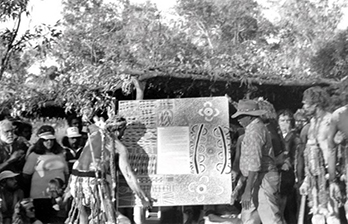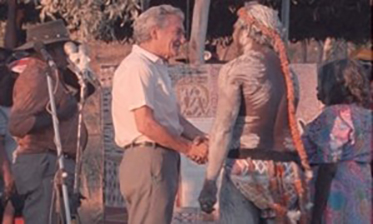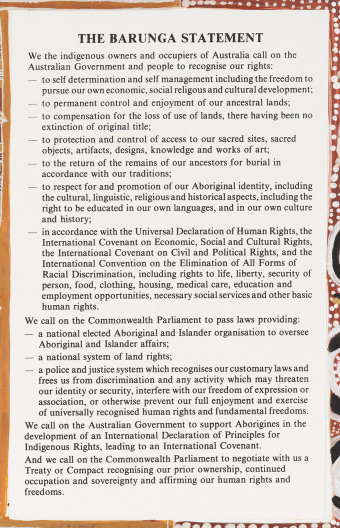Cultural warning: Aboriginal and Torres Strait Islander peoples are advised that the following contains names and images of people who are deceased. The following also contains historic language which may cause offence.
The Barunga Statement calls upon the Australian Government for a national Treaty recognising the human rights, freedoms, and sovereignty of Aboriginal and Torres Strait Islander peoples.
The Northern and Central Land Councils, represented at the time by Yunupingu and Wenten Rubuntja respectively, presented the statement to Prime Minister Bob Hawke on 12 June 1988 at the Barunga Festival held in Barunga, Northern Territory.


Yunupingu, Northern Land Council representative and Wenten Rubuntja, Central Land Council representative, present the Barunga Statement to Prime Minister Bob Hawke, 1988, photograph courtesy of the Central Land Council. Prime Minister Bob Hawke and Yunupingu shake hands after the presentation of the Barunga Statement, 1988, photograph courtesy of Ronin Films.
Hosted by the Jawoyn peoples since 1985, the Barunga Festival brings people from across Australia to participate in music, sports, art, and cultural activities. The festival is also an occasion for social and political advocacy.
The Barunga Statement is one of several highly significant documents in which traditional knowledge is depicted through painting, accompanied by an English-language text for presentation to the Australian Government. Like the Yirrkala Petitions, the painted Dreaming depictions assert continuing ownership, occupation, and authority over Country.
The left-hand side of the Barunga Statement depicts Dreamings from north-eastern Arnhem Land. Crocodile Fire Dreaming of the Madarrpa peoples of the Blue Mud Bay area is at the top; in the centre is the Crocodile Fire Dreaming of the Gumatj peoples in the Caledon Bay area. The lower part of the painting shows the Whale Dreaming of the Trial Bay area. Bakulangay Marawili, Djambawa Marawili AM, Marrirra Warawili, Djewiny Ŋgurruwuthun, Dula Ŋgurruwuthun and Yunupingu AM painted this panel.
The right-hand side of the Barunga Statement depicts Two Women Dreaming, a story of how all the major language groups throughout central Australia were united through the travels of two women. The top and lower sections of the painting depict women gathering at Ulpanyali and Ilpilli, sites south-west of the Northern Territory. The central design depicts the women coming together to exchange gifts and carry the story on through their Country. Lindsay Turner Jampijinpa, Mr D Williams Japanangka and Wenton Rubuntja AM painted this panel.
Signatory and presenter Yunupingu said,
The dot-style painting of Central Australia and the cross-hatching paintings of Northeast Arnhem Land show that Aboriginal people of different countries, speaking different languages, can unite in the same struggle.1
Directly after being presented with the Statement, Prime Minister Bob Hawke responded to the crowd, declaring that after discussing with Aboriginal leaders and hearing their proposals:
Those proposals, of which I have agreed are these: that there shall be a Treaty negotiated between the Aboriginal people and the Government on behalf of all the people of Australia – and that we would expect, hope and work toward the inclusion of such a Treaty before the end of this Parliament. Non-Aboriginal people of Australia will recognise the injustices of the past, will recognise the obligations that we have to create an Australia in which your [Aboriginal] culture and tradition will not only be able to survive, but flourish. 2
The Hawke Government later abandoned the idea of a Treaty in favour of a policy of reconciliation.
The Hon Bob Hawke MP’s last official act of his prime ministership was to present the Barunga Statement to Parliament House in a ceremony in December 1991. Hawke observed:
…the presence of the Barunga statement in Parliament House ‘calls upon those who follow me’ to continue to pursue its objectives. 3
Outside of Parliament, the Barunga Statement increased public attention to the call for Treaty, including inspiring the first song by an Aboriginal band to chart in Australia, ‘Treaty’ by Yothu Yindi in 1991.

Yunupingu (1948-2023), Gumatj people, Marrirra Marawili (c.1937-2018), Madarrpa people, Bakulangay Marawili (c.1944-2002), Madarrpa people, Djambawa Marawili (born 1953), Madarrpa people, Dula Ŋgurruwuthun (c.1936-2001), Munyuku people, Djewiny Ŋgurruwuthun (c.1940-2001), Munyuku people, Lindsay Turner Jampijinpa (1951-2009), Warlpiri people, Mr D Williams Japanangka (1948-2013), Warlpiri people, Wenten Rubuntja (c.1923-2005), Arrernte people, The Barunga Statement (detail), 1988, Official Gifts Collection, Parliament House Art Collections.
Transcript of the Barunga Statement
We, the Indigenous owners, and occupiers of Australia call on the Australian Government and people to recognise our rights:
- to self determination and self management including the freedom to pursue our own economic, social, religious and cultural development;
- to permanent control and enjoyment of our ancestral lands;
- to compensation for the loss of use of lands, there having been no extinction of original title;
- to protection and control of access to our sacred sites, sacred objects, artifacts, designs, knowledge and works of art;
- to the return of the remains of our ancestors for burial in accordance with our traditions;
- to respect for and promotion of our Aboriginal identity, including the cultural, linguistic, religious and historical aspects, including the right to be educated in our own languages, and in our own culture and history;
- in accordance with the Universal Declaration of Human Rights, the International Covenant on Economic, Social and Cultural Rights, the International Covenant on Civil and Political Rights, and the International Convention on the Elimination of All Forms of Racial Discrimination, including rights to life, liberty, security of person, food, clothing, housing, medical care, education and employment opportunities, necessary social services and other basic human rights.
We call on the Commonwealth Parliament to pass laws providing:
- a national elected Aboriginal and Islander organisation to oversee Aboriginal and Islander affairs;
- a national system of land rights;
- a police and justice system which recognises our customary laws and frees us from discrimination and any activity which may threaten our identity or security, interfere with our freedom of expression or association, or otherwise prevent our full enjoyment and exercise of universally recognised human rights and fundamental freedoms.
We call on the Australian Government to support Aborigines in the development of an International Declaration of Principles for Indigenous Rights, leading to an International Covenant.
And we call on the Commonwealth Parliament to negotiate with us a Treaty or Compact recognising our prior ownership, continued occupation and sovereignty, and affirming our human rights and freedoms.
References
1. As cited in: Yunupingu, G, ‘Indigenous Art in the Olympic Age’ published in Art and Australia, vol. 35, no. 1, 1997.
2. AIATSIS, ‘Prime Minister Bob Hawke AC speaking at the Barunga Sport and Cultural Festival, 12 June 1988’, filmed 1988, uploaded 2018. Accessed online via: https://vimeo.com/271802791
3. University of South Australia, ‘Speech for hanging of the Barunga Statement’, deliver by Bob Hawke 20 December 1991, published 1991. Accessed online via: https://unisa.alma.exlibrisgroup.com/view/delivery/61USOUTHAUS_INST/12142276010001831